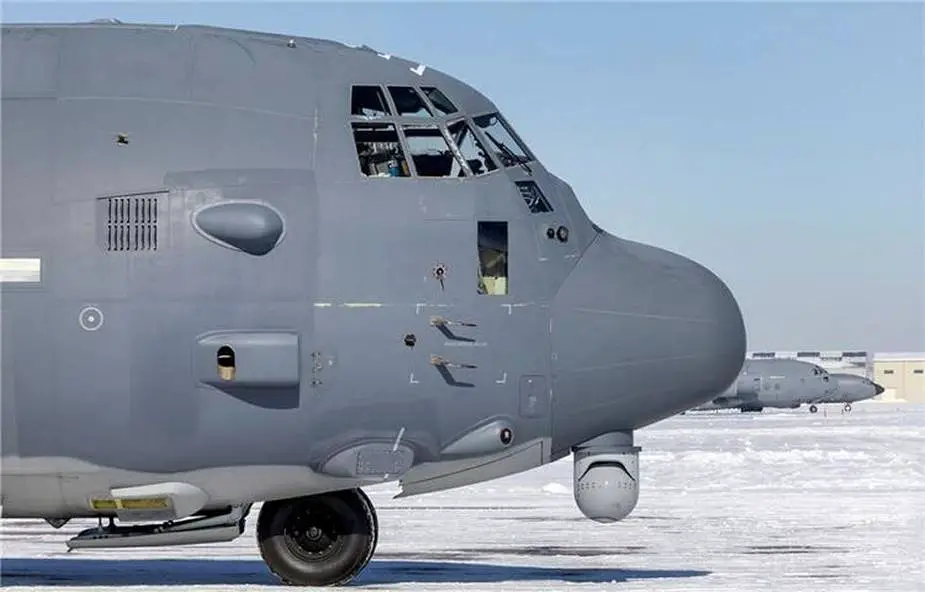Northrop Grumman ALQ-251 radio frequency countermeasure (RFCM) system has been delivered to U.S. Special Operations Command as part of an AC-130J Super Hercules aircraft upgrade. The ALQ-251 will provide superior situational awareness and protection against electronic warfare systems and radar-guided weapons in contested and congested electromagnetic spectrum environments. The Sierra Nevada Corporation is the integrator for the AC-130J Ghostrider and MC-130J Commando II RFCM program.
Follow Air Recognition on Google News at this link
 Northrop Grumman ALQ-251 radio frequency countermeasure (RFCM) system has been delivered to U.S. Special Operations Command as part of an AC-130J Super Hercules aircraft upgrade. (Picture source: courtesy of Sierra Nevada Corporation)
Northrop Grumman ALQ-251 radio frequency countermeasure (RFCM) system has been delivered to U.S. Special Operations Command as part of an AC-130J Super Hercules aircraft upgrade. (Picture source: courtesy of Sierra Nevada Corporation)
AC-130J Ghostrider
The AC-130J Ghostrider's primary missions are close air support, air interdiction and armed reconnaissance. Close air support missions include troops in contact, convoy escort and point air defense. Air interdiction missions are conducted against preplanned targets or targets of opportunity and include strike coordination and reconnaissance and overwatch mission sets. The AC-130J provides ground forces an expeditionary, direct-fire platform that is persistent, ideally suited for urban operations and delivers precision low-yield munitions against ground targets.
The AC-130J is a highly modified C-130J aircraft that contains many advanced features. It contains an advanced two-pilot flight station with fully integrated digital avionics. The aircraft is capable of extremely accurate navigation due to the fully integrated navigation systems with dual inertial navigation systems and a global positioning system. Aircraft defensive systems and color weather radar are integrated as well. The aircraft is capable of air refueling with the Universal Air Refueling Receptacle Slipway Installation system.
Additionally, the AC-130J is modified with the Precision Strike Package, which includes a mission management console, robust communications suite, two electro-optical/infrared sensors, advanced fire control equipment, precision-guided munitions delivery capability, as well as trainable 30mm and 105mm weapons. The mission management system fuses sensor, communication, environment, order of battle and threat information into a common operating picture.
The AC-130J is the fifth generation gunship replacing the aging fleet of AC-130U/W gunships. AC-130 gunships have an extensive combat history dating back to Vietnam where gunships destroyed more than 10,000 trucks and were credited with many life-saving, close air support missions. Over the past four decades, AC-130s have deployed constantly to hotspots throughout the world in support of special operations and conventional forces. In South America, Africa, Europe and throughout the Middle East, gunships have significantly contributed to mission success.
The AC-130J aircraft was officially named Ghostrider in May 2012. The first AC-130J aircraft completed th developmental test and evaluation in June 2015. Initial operational capacity was reached in 2017; full operational capability is forecast for FY25. The first AC-130J squadron, the 73rd Special Operations Squadron, was activated at Hurlburt Field, Florida, Feb. 23, 2018. The last AC-130J delivery is scheduled for the fiscal year 2024.
MC-130J Commando II
The MC-130J Commando II multimission combat transport/special operations tanker, assigned to the Air Force Special Operations Command (AFSOC), delivers increased combat performance to the warfighter with its more powerful engines and unique features. As it replaces the older MC-130N/P Combat Shadow II aircraft, the MC-130J provides AFSOC with a modern aircraft capable of worldwide employment for missions requiring clandestine single- or multi-ship low-level aerial refueling of Special Operation Force vertical and tilt-rotor aircraft and/or infiltration, resupply and exfiltration by airdrop, or landing on remote airfields.
















